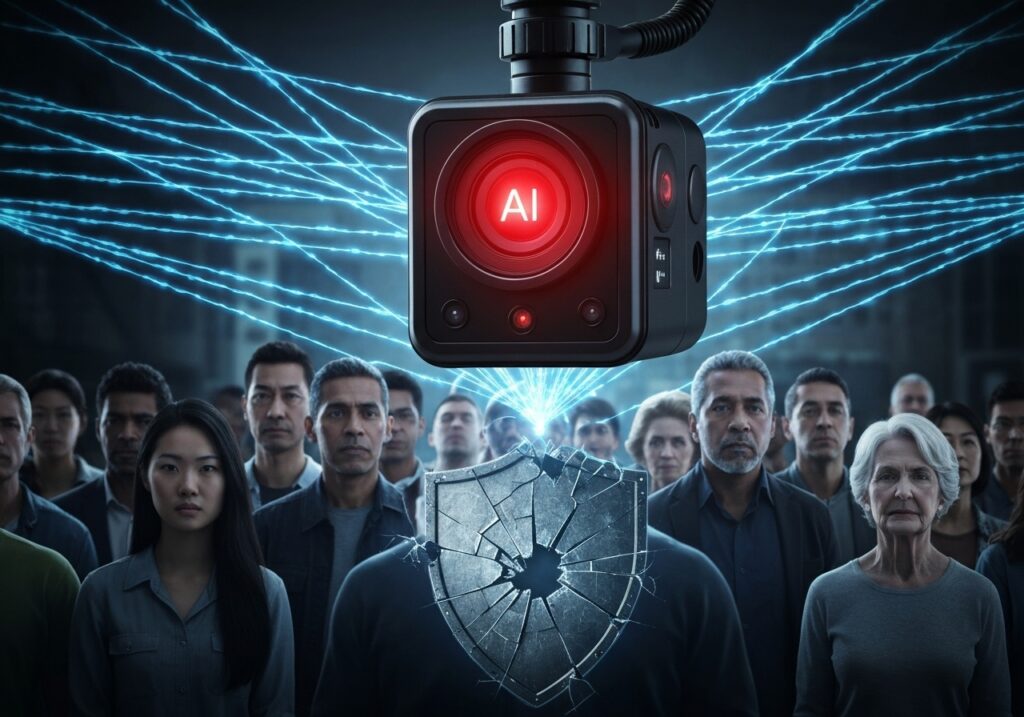The landscape of modern policing is undergoing a significant transformation, driven by the rapid integration of artificial intelligence into police body cameras. While initially hailed as instruments for fostering transparency and accountability, these AI-powered devices are now at the forefront of a contentious debate, raising profound concerns about individual privacy, the potential for systemic bias, and the urgent need for robust oversight.
A recent report by the R Street Institute, a prominent Washington think tank, underscores these alarms, highlighting how the capabilities of AI — particularly facial recognition and real-time video analytics — are blurring the lines between public security and state surveillance. As law enforcement agencies increasingly adopt these sophisticated tools, the imperative to establish clear ethical boundaries and regulatory frameworks becomes ever more critical to safeguard civil liberties.
THE EVOLUTION OF POLICE BODY CAMERAS
Police body-worn cameras (BWCs) first gained widespread adoption in the 2010s, largely in response to public demand for greater transparency and accountability in police-civilian interactions. The initial vision was straightforward: to provide an objective record of encounters, thereby reducing misconduct, protecting both officers and citizens, and facilitating investigations. These devices were seen as a crucial step towards rebuilding public trust.
However, the technological capabilities of BWCs have advanced far beyond simple video recording. The integration of artificial intelligence has propelled them into a new era, endowing them with the power to analyze, interpret, and even predict. This shift represents a fundamental change in their function, moving them from passive recorders to active surveillance tools. This evolution, while promising enhanced efficiency and predictive policing capabilities, simultaneously introduces complex ethical dilemmas that were not present in earlier iterations of the technology.
THE DOUBLE-EDGED SWORD OF AI INTEGRATION
The marriage of AI with police body cameras presents a paradoxical duality. On one hand, proponents argue that AI can significantly enhance law enforcement operations, offering benefits such as faster identification of suspects, real-time alerts for potential threats, and more efficient data analysis for post-incident reviews. The ability to quickly process vast amounts of visual data could theoretically lead to quicker resolutions of crimes and a more proactive approach to public safety.
On the other hand, the risks associated with this advanced integration are substantial and far-reaching. The R Street Institute’s report articulates these concerns vividly, emphasizing three primary areas of vulnerability:
- Privacy Erosion: AI-powered body cameras possess the capacity for constant, indiscriminate surveillance. They don’t merely record crimes; they capture intimate moments, individuals experiencing distress, medical emergencies, or simply going about their daily lives within their homes or public spaces. The collection of such sensitive data, often without explicit consent or awareness, fundamentally infringes upon individuals’ reasonable expectation of privacy. When combined with advanced analytics from companies like Clearview AI or Palantir, this footage can be analyzed in real-time, creating comprehensive profiles of individuals and their movements, often without clear rules governing its use or retention.
- Bias Amplification: Perhaps one of the most alarming risks is the potential for AI systems to perpetuate or even exacerbate existing societal biases, particularly racial bias. Facial recognition algorithms, for instance, have been repeatedly shown to exhibit lower accuracy rates when identifying individuals from marginalized communities, especially women and people of color. A critical example cited in the report is the wrongful arrest of Robert Williams, a Black man in Michigan, who was misidentified by a facial recognition system in 2020. Such errors not only lead to false arrests and profound personal distress but also erode trust between law enforcement and the communities they serve. These systems can transform algorithmic flaws into real-world injustices.
- Lack of Transparency and Oversight: The rapid deployment of AI technologies in policing has often outpaced the development of corresponding legal and ethical frameworks. Many police departments implement these tools without clear, publicly accessible policies on data collection, storage, sharing, and usage. This lack of transparency makes it challenging for the public and oversight bodies to understand how these systems operate, how decisions are made, and how potential abuses can be prevented or remedied. The absence of robust human oversight, as stressed by Logan Seacrest, one of the report’s authors, means that AI might make “final decisions by itself” without the necessary human judgment or ethical consideration.
KEY CONCERNS IDENTIFIED BY EXPERTS
The R Street Institute’s findings serve as a stark warning, highlighting specific instances and systemic vulnerabilities. The report explicitly states that “the line between public security and state surveillance lies not in technology, but in the policies that govern it,” advocating for a policy-first approach to AI deployment.
The case of police officers in New Orleans, who were found to be using facial recognition technology across a private network of over 200 surveillance cameras in violation of city policy, exemplifies the dangers of unchecked technological adoption. This “warrantless algorithm dragnet,” as Seacrest termed it, sparked significant public backlash and prompted the city to propose an ordinance that would broaden police use of the technology, rather than restrict it further.
Furthermore, the report details how “predictive systems can also open the door to invasive surveillance,” underscoring that without clear and enforceable policies protecting civil liberties, these powerful tools are ripe for abuse. The danger lies not just in deliberate misuse but also in the unintended consequences of flawed algorithms or insufficient human oversight.
While the primary concern revolves around surveillance applications like facial recognition, AI’s role in policing extends to administrative tasks, such as drafting incident reports or summarizing large datasets. Tools that leverage large language models, for instance, can assist in processing textual information captured during an investigation, streamlining documentation. One such example of this underlying technology is available through a Free ChatGPT service. However, even these seemingly innocuous applications demand stringent ethical guidelines and human oversight to prevent bias, ensure accuracy, and protect civil liberties, reinforcing the need for comprehensive policy frameworks across all AI deployments in law enforcement.
NAVIGATING THE REGULATORY LANDSCAPE
To mitigate the significant risks posed by AI-powered body cameras, the R Street Institute proposes a series of critical recommendations aimed at bolstering state regulations:
- Requiring Warrants: Mandating judicial warrants for the use of facial recognition technology, similar to warrants required for physical searches, would introduce a crucial layer of judicial oversight and protect against arbitrary surveillance.
- Higher Accuracy Thresholds: Establishing minimum accuracy standards for AI systems, especially those involved in identification, would help prevent misidentifications and their serious consequences.
- Limiting Data Retention: Implementing strict limits on how long body camera footage and the data derived from it can be retained is vital to prevent indefinite surveillance and reduce the risk of data breaches or misuse.
- Mandating Regular Audits: Requiring independent and regular audits of AI systems used by law enforcement can help identify and address racial or systemic biases embedded in the algorithms or their application.
- Human-in-the-Loop Principle: Emphasizing that AI should never make final decisions regarding arrests or flagging individuals without significant human review by law enforcement professionals, attorneys, and software engineers is paramount. This ensures that human judgment, ethical considerations, and accountability remain central to the process.
Several states have begun to address these concerns through legislation. California, for instance, previously passed a law prohibiting the use of facial recognition on police-worn cameras, although this prohibition expired in 2023, highlighting the fluctuating nature of such regulations. Illinois has taken a more permanent stance by strengthening its Law Enforcement Officer-Worn Body Camera Act. This updated legislation includes critical provisions such as mandating retention limits, explicitly prohibiting live biometric analysis, and requiring officers to deactivate recordings under certain sensitive circumstances, such as in private residences or during medical emergencies. These state-level efforts demonstrate a recognition of the need for specific guardrails around AI use in policing.
The report posits that “there’s nothing inherently incompatible about AI and civil liberties, or AI and privacy with proper democratic oversight.” This optimistic outlook hinges entirely on the implementation of thoughtful and enforceable policies. The debate continues regarding whether national standards or state and local regulations are most effective. Seacrest suggests that regulations are often best when “created and actuated closest to the people that they affect,” implying a preference for state and local oversight, allowing for tailored approaches that reflect community values and specific needs.
ENSURING ACCOUNTABILITY AND PUBLIC TRUST
Beyond specific legislative mandates, building public trust in AI-powered policing necessitates a broader commitment to accountability. This involves proactive measures from law enforcement agencies and robust engagement with the communities they serve. Key elements include:
- Public Dialogue and Engagement: Agencies should engage in transparent conversations with civil rights organizations, privacy advocates, and community leaders before deploying new AI technologies. This collaborative approach can help address concerns early and build consensus on acceptable uses.
- Independent Review Boards: Establishing independent bodies with the authority to review and audit the use of AI systems, investigate complaints, and recommend policy changes can provide an essential layer of external accountability.
- Ethical AI Guidelines: Developing comprehensive ethical guidelines that prioritize human rights, fairness, and non-discrimination as foundational principles for AI development and deployment within law enforcement. These guidelines should inform procurement decisions, training protocols, and ongoing system evaluations.
- Officer Training: Ensuring that officers are not only trained on how to operate AI-enabled body cameras but also understand the ethical implications, privacy considerations, and the limitations of the technology. This training should emphasize the importance of human discretion and the “human in the loop” principle.
- Data Security and Management: Implementing state-of-the-art cybersecurity measures to protect the vast amounts of sensitive data collected by these cameras from unauthorized access, breaches, or misuse. Clear data governance policies are crucial for managing this digital footprint responsibly.
THE PATH FORWARD: BALANCING INNOVATION AND RIGHTS
The integration of artificial intelligence into police body cameras represents a powerful technological advancement with the potential to reshape law enforcement. However, its promise can only be fully realized if accompanied by a steadfast commitment to protecting fundamental rights and fostering public trust. The current inconsistency in government oversight, coupled with a dearth of national standards, underscores the urgency of this challenge. While state and local regulations offer the flexibility to adapt to diverse community needs, a cohesive national dialogue and shared best practices could provide a valuable framework.
The core tension remains: leveraging technology for public safety without inadvertently creating a pervasive surveillance state. As the R Street Institute report concludes, the same powerful tools that could be abused by authoritarian regimes can, with proper democratic oversight and constitutional adherence, benefit all Americans. It is fundamentally “a matter of the guardrails that we put in place for it.” Proactive policy-making, continuous evaluation, and a vigilant public are essential to ensuring that AI-powered police body cameras serve as tools of justice and accountability, rather than instruments that erode privacy and exacerbate inequality.

